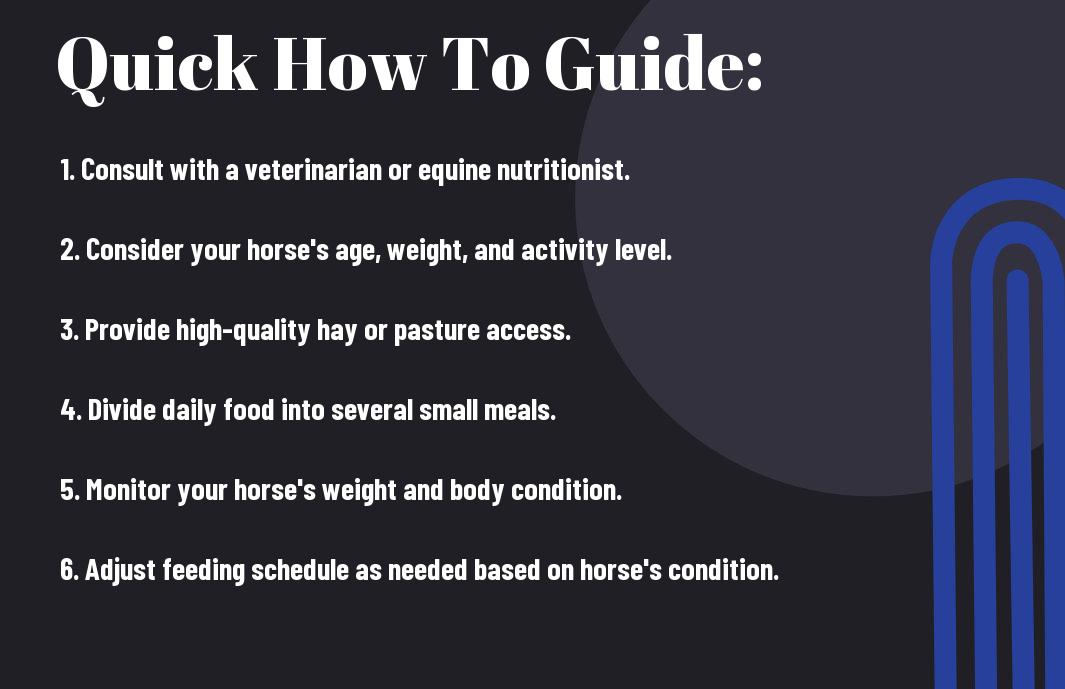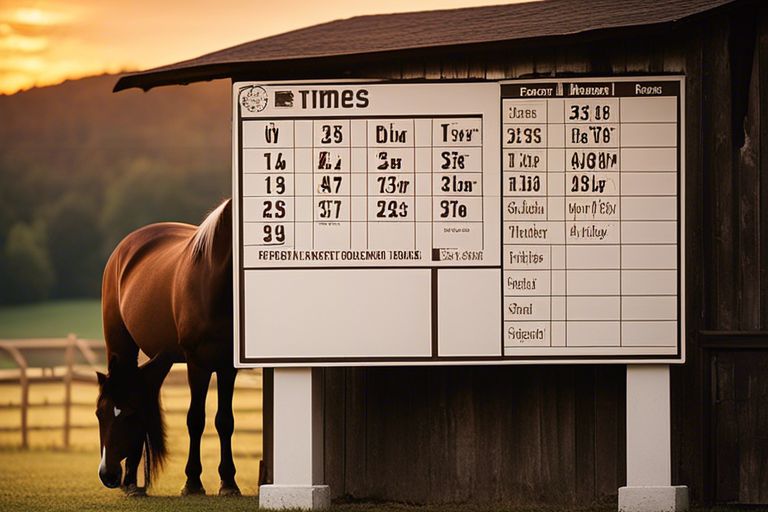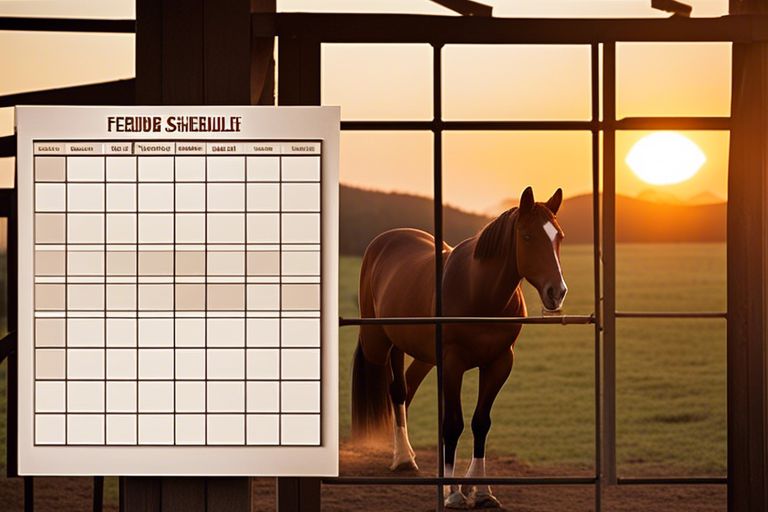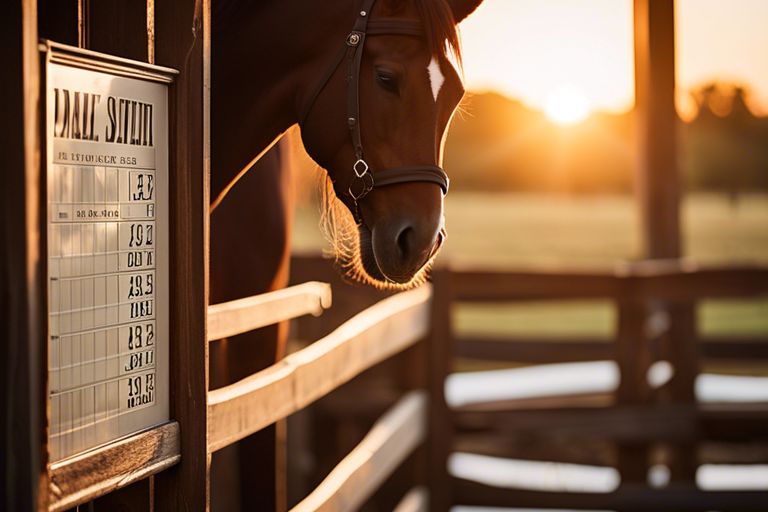Horse owners know that proper nutrition is vital for the health and well-being of their equine companions. In this guide, you will learn how to craft an effective feeding schedule that meets your horse’s unique dietary needs. By understanding the importance of a balanced diet, you can ensure your horse maintains optimal health and performance. Follow these practical tips to establish a feeding routine that will keep your horse healthy and thriving.

Understanding Your Horse’s Nutritional Needs
Before developing a feeding schedule for your horse, it’s important to understand factors affecting nutrient requirements. Your horse’s age, weight, activity level, and overall health will all influence the amount and type of nutrients it needs. Younger horses, pregnant or lactating mares, and performance horses have higher nutritional demands compared to adult, sedentary horses. Environmental factors such as temperature, humidity, and access to forage also play a role in determining your horse’s nutritional needs.
Factors Affecting Nutrient Requirements
- Age: Younger horses have higher nutritional demands for growth and development.
- Activity Level: Performance horses require more energy and certain nutrients to support their exercise regimen.
- Health: Any health issues, such as metabolic disorders or dental problems, can impact your horse’s ability to digest and utilize nutrients effectively.
After considering these factors, you can better tailor your horse’s diet to meet its specific needs.
Horses have specific dietary requirements in order to maintain optimal health and performance. Clearly identifying your horse’s nutrient needs will help you design a feeding program that meets those requirements. Factors such as the horse’s age, breed, workload, and overall health should all be taken into consideration when determining the appropriate balance of protein, carbohydrates, vitamins, and minerals in its diet.
Determining Your Horse’s Nutrient Needs
With proper assessment, you can ensure that your horse receives the necessary nutrients to thrive. Pay attention to any signs of deficiency or excess, such as poor coat condition, weight loss, or behavioral changes. Adjusting your horse’s diet accordingly can help prevent health issues and optimize its performance and well-being.
Assessing Your Horse’s Lifestyle and Environment
Some important factors to consider when developing a feeding schedule for your horse include evaluating your horse’s age, breed, and size.
Evaluating Your Horse’s Age, Breed, and Size
For example, a young, rapidly growing horse may have different nutritional needs compared to an older horse. Different horse breeds may also have varying requirements, such as ponies needing less food than larger draft horses due to their size. It’s necessary to take into account these individual characteristics to tailor a feeding schedule that meets your horse’s specific needs.
Considering Your Horse’s Level of Activity is another crucial aspect to consider.
Considering Your Horse’s Level of Activity
You should adjust your horse’s feeding plan based on the level of activity they participate in. A horse in heavy training or involved in strenuous activities will require more calories and nutrients than a horse with a more sedentary lifestyle. Be sure to provide the appropriate amount of feed to support your horse’s energy requirements and overall health.
With Climate and Geographic Factors, you need to be aware of how these variables can impact your horse’s feeding schedule.
Climate and Geographic Factors
- Temperature: Cold weather may require additional calories to maintain body heat, while hot weather can increase the risk of dehydration.
- Altitude: Horses at high altitudes may need more time to acclimate and adjust their feeding routine accordingly.
- Access to grazing: Availability of fresh pasture and forage can influence the need for supplemental feeds.
This information is crucial in designing a feeding plan that takes into account the environmental conditions your horse experiences.
Clearly, Climate and Geographic Factors play a significant role in determining your horse’s nutritional requirements. It’s necessary to consider temperature, altitude, and access to grazing when establishing a feeding schedule. This knowledge will help you provide the appropriate diet to keep your horse healthy and thriving.

Choosing the Right Feed for Your Horse
Now, let’s discuss how to select the most suitable feed for your horse. In terms of feeding your horse, there are several options to consider, including hay, grains, and supplements. Each type of feed plays a crucial role in providing your horse with the necessary nutrients and energy for optimal health and performance. It’s important to understand the differences between these feed options to create a well-balanced diet for your horse.
Types of Horse Feed: Hay, Grains, and Supplements
| Feed Type | Description |
| Hay | Consists of grasses or legumes, high in fiber, important for digestive health |
| Grains | Provide concentrated sources of energy, protein, and other nutrients |
| Supplements | Additional nutrients or ingredients to complement the basic diet |
The key is to provide a balanced mix of hay, grains, and supplements to meet your horse’s specific nutritional requirements. The right combination will depend on factors such as your horse’s age, activity level, and overall health. The quality of these feeds is crucial for your horse’s well-being.
Selecting High-Quality Feed Sources
Feed your horse high-quality hay and grains to ensure they receive the necessary nutrients for optimal health and performance. This includes choosing hay that is free of mold, dust, and weeds, as well as grains that are fresh and properly stored. Additionally, when selecting supplements, look for products from reputable manufacturers with proven track records for safety and effectiveness.
This ensures that your horse gets the best possible nutrition without being exposed to harmful contaminants. By prioritizing quality in your horse’s feed sources, you can help prevent potential health issues and support their overall well-being. Note, the health of your horse starts with the quality of their feed.
Tips for Reading Feed Labels
Assuming you are trying to make informed decisions about your horse’s feed, it’s crucial to know how to read and understand feed labels properly. Pay attention to the ingredients, nutrient levels, and feeding recommendations provided on the label. This information can help you determine if the feed is suitable for your horse’s specific needs. Thou shalt also look for any warning labels or precautions to ensure the feed is safe for your horse.
Plus, remember that the order of ingredients listed on the label indicates their relative amounts in the feed. Ingredients are listed by weight, with the heaviest components listed first. Key nutrients such as protein, fiber, and fat should be present in appropriate amounts based on your horse’s requirements. By carefully examining feed labels, you can make educated decisions about which feeds are best for your horse’s nutritional needs.
Creating a Feeding Schedule
How to Determine the Right Feeding Frequency
Despite each horse being unique, there are general guidelines to help you determine the right feeding frequency for your horse. Feed your horse at least twice a day, ideally spreading out meals to mimic their natural grazing patterns. Some horses may require more frequent, smaller meals to maintain a healthy digestive system. Monitor your horse’s weight, energy levels, and overall health to adjust the feeding frequency accordingly.
Calculating Your Horse’s Daily Ration
On average, a horse should consume about 2% of its body weight in forage daily, such as hay or pasture. This can vary based on the horse’s age, activity level, and metabolic rate. Consult with your veterinarian or equine nutritionist to determine the appropriate daily ration for your horse.
This ensures that your horse receives the necessary nutrients without over or underfeeding, promoting optimal health and performance.
Tips for Managing Meal Times and Portion Control
To effectively manage your horse’s meal times and portion control, consider the following tips:
- Use a feeding schedule to establish routine and consistency.
- Divide the daily ration into multiple feedings to prevent overeating and promote digestion.
- Monitor your horse’s body condition and adjust the ration as needed to maintain a healthy weight.
This will help prevent digestive issues and maintain your horse’s overall well-being.

Monitoring and Adjusting Your Horse’s Feeding Schedule
Unlike humans, horses cannot tell you when they are feeling off or if their diet is lacking in crucial nutrients. It’s important to actively monitor and adjust your horse’s feeding schedule to ensure they stay healthy and happy.
Tracking Your Horse’s Weight and Body Condition
On a regular basis, you should weigh your horse and assess their body condition score to ensure they are maintaining a healthy weight. Any sudden weight loss or gain could indicate an issue with their diet. Keeping a record of their weight and body condition over time will help you track any changes and adjust their feeding schedule accordingly.
Identifying Signs of Nutrient Deficiencies or Excesses
Any changes in your horse’s behavior, coat quality, hoof health, or overall performance could be signs of nutrient deficiencies or excesses. For instance, a dull coat or lethargic behavior may indicate a lack of crucial vitamins or minerals in their diet.
Making Adjustments to the Feeding Schedule
Little changes to your horse’s feeding schedule can have a big impact on their overall health and well-being. If you notice any signs of nutrient deficiencies or excesses, it’s important to adjust their diet accordingly. Excesses of certain nutrients can be just as harmful as deficiencies, so it’s crucial to find the right balance for your horse.

Common Mistakes to Avoid in Feeding Your Horse
Overfeeding or Underfeeding Your Horse
To ensure your horse’s health and well-being, it is crucial to provide the right amount of feed. Overfeeding your horse can lead to obesity, which increases the risk of health issues such as laminitis and metabolic disorders. Conversely, underfeeding your horse can result in deficiencies in imperative nutrients, leading to poor condition, lack of energy, and other health problems. It’s important to consult with a veterinarian or equine nutritionist to determine the appropriate feeding plan for your horse based on their individual needs and workload.
Inadequate Hydration and Electrolyte Balance
There’s an imperative aspect of your horse’s diet that is often overlooked – hydration and electrolyte balance. Ensuring your horse has access to clean, fresh water at all times is crucial for their health. Dehydration can lead to serious health issues and decreased performance. Electrolytes are also important for maintaining proper muscle function and hydration levels, especially for horses in intense work or hot climates.
Mistakes in managing your horse’s hydration and electrolyte balance can have serious consequences. It’s important to provide electrolyte supplements as needed, especially during hot weather or increased physical activity, to help maintain the balance in your horse’s body.
Failing to Account for Changes in Your Horse’s Needs
Common horse can have changing nutritional needs depending on factors such as age, workload, health status, and environmental conditions. Failing to adjust your horse’s feeding schedule and diet accordingly can result in nutritional imbalances and health issues. Regularly reassess your horse’s diet and consult with a professional to ensure they are receiving the proper nutrients for their current stage of life and activity level.
To wrap up
Drawing together all the information gathered, you now have a clearer understanding of how to develop an effective feeding schedule for your horse. By considering factors such as your horse’s age, weight, activity level, and overall health, you can create a feeding plan that provides the necessary nutrients while preventing issues like obesity or digestive problems.
Remember to consult with your veterinarian or equine nutritionist to fine-tune the feeding schedule and make any necessary adjustments based on your horse’s individual needs. By prioritizing your horse’s health and well-being through a well-balanced feeding schedule, you can ensure that your equine companion stays healthy, happy, and thriving.
FAQ
Q: Why is an effective feeding schedule important for my horse?
A: An effective feeding schedule is important for your horse’s health and well-being. It ensures they receive the necessary nutrients in the right amounts at the right times to support their energy levels, growth, and overall performance.
Q: How can I determine the right feeding schedule for my horse?
A: To determine the right feeding schedule for your horse, consider their age, weight, activity level, and any specific dietary requirements they may have. Consult with a veterinarian or equine nutritionist for personalized recommendations.
Q: What are the key components of an effective feeding schedule for horses?
A: An effective feeding schedule for horses typically includes a balance of quality forage, concentrates, and supplements, divided into multiple meals throughout the day. It should also consider factors like grazing opportunities, water intake, and the horse’s individual needs.
Q: How should I transition my horse to a new feeding schedule?
A: When transitioning your horse to a new feeding schedule, make gradual changes over a period of 1-2 weeks to allow their digestive system to adjust. Monitor your horse’s health and behavior during the transition period and adjust the schedule as needed.
Q: What are some common feeding schedule mistakes to avoid?
A: Common feeding schedule mistakes to avoid include overfeeding or underfeeding, feeding low-quality forage or concentrates, offering inadequate water, and inconsistent feeding times. Regularly evaluate and adjust your horse’s feeding schedule to ensure it meets their nutritional needs.











